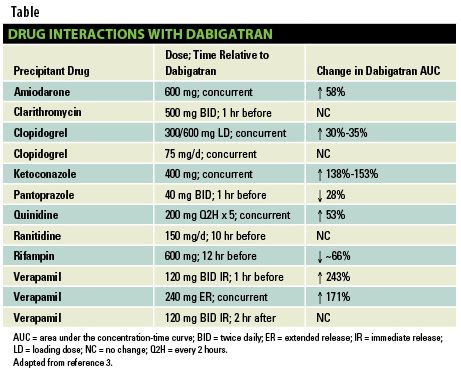Publication
Article
Pharmacy Times
Dabigatran: A New Oral Anticoagulant
Patients taking dabigatran etexilate should be closely monitored for altered responses to this newly approved oral anticoagulant.
Patients taking dabigatran etexilate should be closely monitored for altered responces to this newly approved oral anticoagulant.
Dabigatran etexilate (DE; Pradaxa) was recently approved by the FDA as an oral anticoagulant (direct inhibitor of factor IIa, thrombin) for patients with atrial fibrillation.1 Unlike warfarin, this drug is not metabolized by cytochrome P450 enzymes and is less susceptible to drug or disease interactions. It is, however, primarily eliminated by the kidneys, and reduced renal function will result in drug accumulation; dose reductions are suggested in patients with renal dysfunction. The Table summarizes interaction studies reported with dabigatran.

Dabigatran Pharmacology.
DE is a prodrug that has a low (3%-7%) bioavailability. This is partially due to its physicochemical properties (poor solubility at pH >3.0—tartaric acid is included in the dosage form) and its absorptionlimiting transport out of enterocytes by P-glycoprotein (P-gp). The prodrug is hydrolized to the active dabigatran by carboxylesterases. Dabigatran has a half-life of about 12 hours and is primarily eliminated by glomerular filtration.
Drug Interactions, pH based.
DE requires an acidic environment for dissolution and absorption. The administration of pantoprazole 40 mg twice daily reduced the mean area under the concentrationtime curve (AUC) of dabigatran by 28% and its peak concentration by 45%.2 Mean gastric pH during pantoprazole was 5.9. Other proton pump inhibitors would be expected to produce a similar reduction in dabigatran plasma concentrations. Ranitidine 150 mg daily administered 10 hours before a dose of dabigatran had no effect on dabigatran’s plasma concentrations. Gastric pH was not reported.
Drug Interactions, P-gp Based.
DE is a substrate for P-gp, but the active drug is not. Because only the prodrug DE is a substrate for P-gp, its absorption can be altered by P-gp inducers or inhibitors during its pass through the enterocyte. Once DE is absorbed and converted to the active moiety, it is no longer susceptible to P-gp inhibitors. P-gp inhibitors, including amiodarone, ketoconazole, quinidine, and verapamil, increase the AUC of dabigatran from about 50% to over 200%. Other P-gp inhibitors will likely produce similar changes in dabigatran plasma concentrations. Studies demonstrated that immediate- release verapamil administered 1 hour before dabigatran produced the largest effect. Administration of dabigatran 2 hours before verapamil completely avoided the interaction.
Clopidogrel is a substrate for P-gp. The loading dose (300-600 mg) may be large enough to compete with dabigatran for enterocyte P-pg, whereas the smaller maintenance dose (75 mg) produces no pharmacokinetic interaction. Other inhibitors of P-gp, including dronedarone, diltiazem, cyclosporine, itraconazole, propafenone, and ritonavir, may also increase the AUC of dabigatran.
Rifampin, a P-gp inducer, decreases the AUC of dabigatran by about 66%. Separation of doses is unlikely to reduce the magnitude of this interaction. Doses of dabigatran will likely require an increase during concurrent rifampin administration. St. John’s wort and carbamazepine may also reduce dabigatran concentrations.
Clinical Significance.
Clinical experience is limited, but some of the changes noted are likely to alter patient response to dabigatran. Patients stabilized on dabigatran should be monitored for altered response (bleeding or loss of anticoagulant effect) if P-gp inhibitors or inducers are added or removed from their drug regimen. Administration of dabigatran more than 2 hours before a P-gp inhibitor should minimize the effect of the inhibitor on dabigatran absorption. Finally, the administration of other anticoagulants or antiplatelet drugs would be expected to increase the risk of bleeding in patients taking dabigatran. PT
Drs. Horn and Hansten are both professors of pharmacy at the University of Washington School of Pharmacy. For an electronic version of this article, including references, if any, visit www.hanstenandhorn.com.







